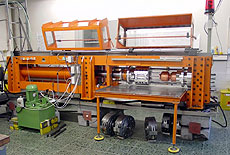Seamless cavity performance
 |
DESY’s hydroforming machine. Image courtesy of Waldemar Singer, via ILC Newsline. |
Laboratories in the US begin to take a serious look at hydroforming as a method for creating ILC-type cavities.
Researchers in the US may soon be pumping their cavities into shape.
Last year Fermilab scientists put out a call to industrial companies to propose a procedure for hydroforming ILC-type cavities. They hope that by next year, the selected company will provide Fermilab with three hydroformed nine-cell cavities for testing.
“Hydroforming’s a good idea whose time has come,” said Fermilab scientist Andy Hocker, who has led the lab’s effort in hydroforming research.
To hydroform ILC cavities, a seamless tube of niobium with the right mechanical properties is set in a cavity-shaped die. Water, pressurised to hundreds of atmospheres, is pumped into the tube and pushes out against the tube wall until it conforms to the mould. In ten minutes, the metal is shaped into the cavity’s familiar beads-on-a-string form.
The resulting shape, sculpted from a single piece of metal, is without seams or welds. Scientists see this as the method’s primary advantage over the standard procedure for forming cavities. There, 18 cup-shaped half-cells are each welded by an electron beam to the next, forming the nine-cell structure.
“The weld is such a trouble spot,” Hocker said. Welding is a complicated process, each step of which invites error. Also, most of the consequential defects in the cavity appear near welds (especially those at the equator, the widest part of the cell). “They’re a headache. Everybody would love to be rid of them.”
Being rid of them could also mean potential cost savings in fabrication and improved reproducibility in performance.
The process of hydroforming cavities from niobium tubing has been extensively researched at DESY. Waldemar Singer has led this effort within the Coordinated Accelerator Research in Europe programme. Kenji Saito has led similar R&D at KEK in Japan. Both laboratories have successfully fabricated multi-cell cavities with their developed-in-house hydroforming machines. The DESY effort, in particular, is at a stage where industrialisation is the next logical step.
Read more
-- Leah Hesla
|